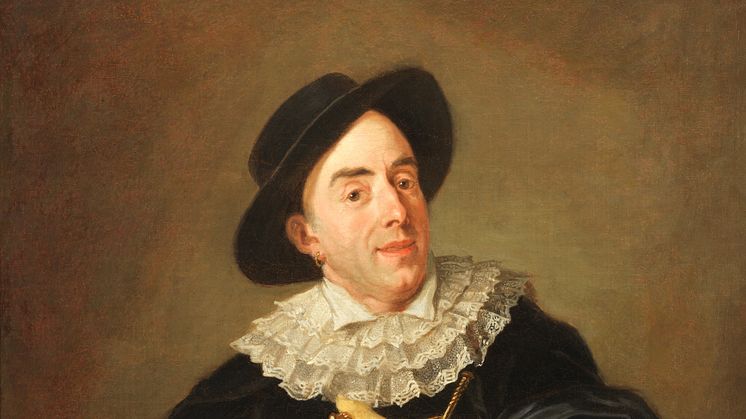
Press release -
Nationalmuseum acquires important actor portrait by artist Carl Fredrik von Breda
Nationalmuseum has acquired a portrait by Carl Fredrik von Breda of the actor Saint-Ange. It is one of a suite of role portraits depicting members of King Gustav III’s French theatre troupe led by the legendary Jacques Marie Boutet, known as Monvel. Besides being a superb example of Gustavian art, the portrait shows the young von Breda’s skill as a portrait painter in his own right.
In 1785, Carl Fredrik von Breda was 26 years old. His older colleagues at the Royal Swedish Academy of Fine Arts (Konstakademien) saw in him a promising young talent. He was an eager participant in exhibitions at the academy and won his first medal at the age of 19 in 1778, the same year he began his studies. In 1785 von Breda was awarded the gold medal, but he missed out on the travel scholarship, which was instituted two years later, and had to find other means of financing his study tour.
The teacher who had the greatest influence on von Breda was Lorens Pasch the younger, a portrait painter and professor at the academy. His influence is evident in the works von Breda produced until leaving Sweden in 1787 to embark on a lengthy study tour of England. There he became acquainted with Sir Joshua Reynolds, one of the leading painters and art theorists of the day. This encounter had a decisive influence on von Breda’s future art, resulting in a complete stylistic overhaul with more artistic brushwork and a different colour palette.
At the age of only 25, von Breda received his first high-profile commission. At the request of Queen Sofia Magdalena, he painted a portrait of her young son, Crown Prince Gustav (IV) Adolf, on his rocking horse (Nationalmuseum, National Portrait Collection, NMGrh 1541). Around the same time, von Breda also worked on portraits of two actors: Jacques Marie Boutet, known as Monvel (Drottningholms Teatermuseum), and Joseph Sauze Desguillons (Nationalmuseum, NM 7011).
The portrait recently acquired by Nationalmuseum depicts another of the French actors, Monsieur Saint-Ange, who performed in Stockholm from 1784 to 1788. The painting, signed Carl Fredrik von Breda and dated 1785, was exhibited at Konstakademien the following year. Saint-Ange is portrayed in the role of Crispin in Jean-François Regnard’s 1704 comedy Les Folies amoureuses. According to the exhibition catalogue from the academy, the portrait shows Saint-Ange speaking the line “Savez vous bien, Monsieur, que j’étois dans Crémone?” (“Are you aware, sir, that I have been in Cremona?”) Crispin is a wily servant in the employ of a young gentleman who is in love with the play’s heroine. In the portrait his mouth is slightly open, as if he is speaking. His expression and the twinkle in his eye hint at the character’s cunning nature. His outfit suggests a degree of snobbery. Bright yellow gloves and a wide belt in the same colour present a bold contrast to his elegant black attire. By using only a few colours and a composition that sets a large figure against a neutral background, the young von Breda created a powerful role portrait. The manner of the painting is reminiscent of von Breda’s teacher, Lorens Pasch the younger, but the work is not lacking in originality. Carl Fredrik von Breda produced a fresh, lively depiction of the actor Saint-Ange in one of his roles. The portraits of Saint-Ange and Desguillons, von Breda’s two finest role portraits in the comic genre, are welcome additions to the Nationalmuseum collection.
This acquisition has been made possible by a generous donation from the Axel Hirsch Foundation. Nationalmuseum has no budget of its own for new acquisitions, but relies on gifting and financial support from private funds and foundations to enhance its collections of fine art and craft.
Inventory number
NMGrh 7380
Media contacts
Eva-Lena Karlsson, Curator, +46 8 519 544 30, eva-lena.karlsson@nationalmuseum.se
Mattias Robertson, Press Officer: +46 767 234632, press@nationalmuseum.se
Topics
Categories
Nationalmuseum is Sweden’s premier museum of art and design. The collections comprise older paintings, sculpture, drawings and graphic art, and applied art and design up to the present day. The museum building is currently under renovation and scheduled to open again in 2018. In the meantime, the museum will continue its activities through collaborations both in Sweden and abroad as well as temporary exhibitions at Nationalmuseum Design at Kulturhuset Stadsteatern in Stockholm. Nationalmuseum has partnerships with Svenska Dagbladet and the Grand Hôtel Stockholm.

